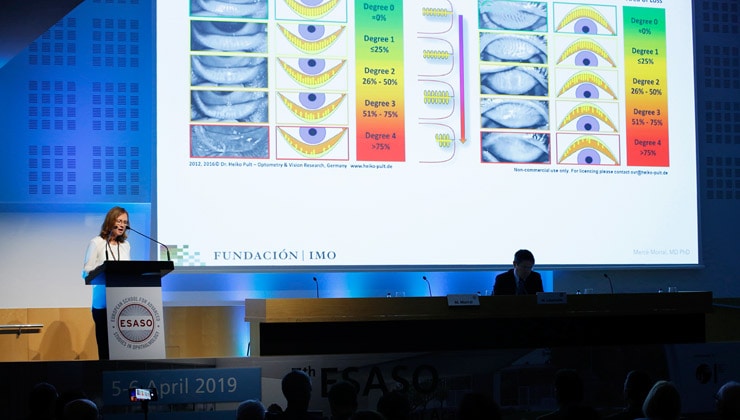Experts offer 5 keys to successful refractive surgery
28 de June de 2019
More than 200 European ophthalmologists met last weekend at the Ocular Microsurgery Institute (IMO) during the fifth edition of ESASO Anterior Segment Academy, a global forum organised by the European School for Advanced Studies in Ophthalmology (ESASO) in collaboration with the the IMO Foundation, where they discussed complications in refractive surgery. Specialists have analysed how to avoid problems in these procedures, which affect less than 1% of all cases, but require good management to minimise some of their most common risks, such as dry eye syndrome.
Tips to avoid complications
In Spain, more than 100,000 corneal refractive surgeries are performed, which correct problems, such as myopia, hyperopia or astigmatism, as well as 500,000 cataract surgeries a year, a technique that is also indicated for correcting presbyopia or tired eyes. “During the conference, we have seen that there are problems in less than 1 out of 3,000 surgeries. Although complications are very rare, we have to know them so that, when they occur, we can treat them and achieve a good end result,” Dr Daniel Elies, an ophthalmologist at the IMO’s Cornea, Cataract and Refractive Surgery Department, explains.
Among the main conclusions of the experts gathered at the conference, he stresses the importance of the active role of the candidate for this surgery, whom they recommend to consider five key points before undergoing the procedure:
- Look for an eye clinic and a specialist with extensive experience in refractive surgery.
- Undergo a complete eye examination prior to surgery to determine if you are a good candidate and which technique is best suited for your case (laser or intraocular lens implantation).
- Ask the specialist for detailed information on how the procedure will be performed, as well as the postoperative period (possible discomfort, when you will start to recover vision, etc.).
- Assess, together with the surgeon, the procedure’s expectations (for example, some morphological changes in the eye structures, especially linked to aging, can cause new refractive defects to arise over the years).
- After surgery, perform annual eye check-ups or as often as indicated by the ophthalmologist, especially people whose high-degree myopia has been corrected.
Dry eye at the forefront of the most common complications

Most complications in refractive surgery are due to not detecting dry eyes early.
The conference, which included presentations, panel discussions and a 3D surgery session, also focused on the most common complications. “Between 20 and 25% of the most common ones are related to not detecting dry eyes early, which can cause problems in the short and long term. In most cases, this is temporary, after three months it usually disappears, but 1% of patients may develop a chronic disease, Dr José Luis Güell, the coordinator of the Cornea, Cataract and Refractive Surgery Department at the IMO and co-organiser of this conference, explains. In this sense, ophthalmologists advise their colleagues to study very well a patient who is mainly intolerant to contact lenses and wishes to undergo refractive surgery, as they are probably suffering from dry eye and, depending on its severity, indicate the most appropriate technique in the preoperative stage. According to Dr Güell, “dry eye, whether diagnosed before or after surgery, limits the surgery results, so knowledge about the way we evaluate and treat this syndrome in refractive surgery candidates is critical.”
Other complications, which are even less frequent and are associated with these refractive surgical procedures, both corneal and intraocular, including cataract surgery, are residual refractive errors, irregular astigmatism or lens rotation, among others. However, “it is important to note that, at present, there is equipment available to guide us before placing an intraocular lens or that allows us to capture images prior to surgery more accurately, thus allowing us to minimise any complication,” Dr Elies concludes.
IMO Institute of Ocular Microsurgery
Josep María Lladó, 3
08035 Barcelona
Phone: (+34) 934 000 700
E-mail: international@imo.es
See map on Google Maps
By car
GPS navigator coordinates:
41º 24’ 38” N – 02º 07’ 29” E
Exit 7 of the Ronda de Dalt (mountain side). The clinic has a car park with more than 200 parking spaces.
By bus
Autobus H2: Rotonda de Bellesguard, parada 1540
Autobus 196: Josep Maria Lladó-Bellesguard, parada 3191
Autobuses H2, 123, 196: Ronda de Dalt – Bellesguard, parada 0071
How to arrive at IMO from:
IMO Madrid
C/ Valle de Pinares Llanos, 3
28035 Madrid
Phone: (+34) 910 783 783
See map in Google Maps
Public transport
Metro Lacoma (líne 7)
Autobuses:
- Lines 49 & 64, stop “Senda del Infante”
- Line N21, stop “Metro Lacoma”
Timetables
Patient care:
Monday to Friday, 8 a.m. to 9 p.m.
IMO Andorra
Av. de les Nacions Unides, 17
AD700 Escaldes-Engordany, Andorra
Phone: (+376) 688 55 44
See map in Google Maps
IMO Manresa
C/ Carrasco i Formiguera, 33 (Baixos)
08242 – Manresa
Tel: (+34) 938 749 160
See map in Google Maps
Public transport
FGC. Line R5 & R50 direction Manresa. Station/Stop: Baixador de Manresa
Timetables
Monday to Friday, 08:30 A.M – 13:30 PM / 15:00 PM – 20:00 PM




